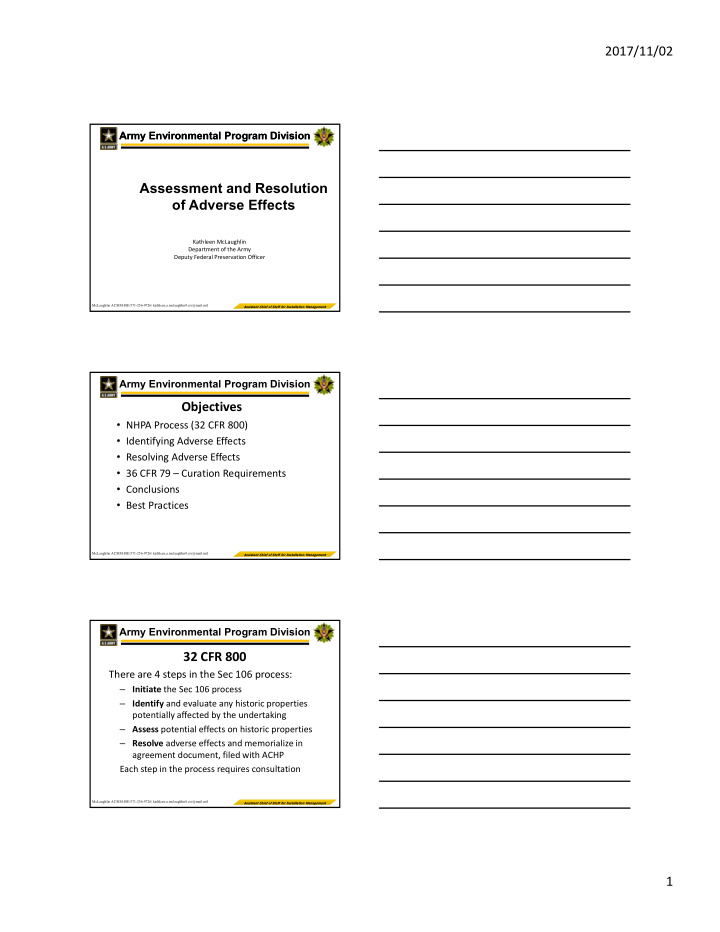



2017/11/02 Army Environmental Program Division Army Environmental Program Division Assessment and Resolution of Adverse Effects Kathleen McLaughlin Department of the Army Deputy Federal Preservation Officer McLaughlin ACSIM-ISE/571-256-9726/ kathleen.a.mclaughlin8.civ@mail.mil Assistant Chief of Staff for Installation Management Assistant Chief of Staff for Installation Management Army Environmental Program Division Objectives • NHPA Process (32 CFR 800) • Identifying Adverse Effects • Resolving Adverse Effects • 36 CFR 79 – Curation Requirements • Conclusions • Best Practices McLaughlin ACSIM-ISE/571-256-9726/ kathleen.a.mclaughlin8.civ@mail.mil Assistant Chief of Staff for Installation Management Assistant Chief of Staff for Installation Management Army Environmental Program Division 32 CFR 800 There are 4 steps in the Sec 106 process: – Initiate the Sec 106 process – Identify and evaluate any historic properties potentially affected by the undertaking – Assess potential effects on historic properties – Resolve adverse effects and memorialize in agreement document, filed with ACHP Each step in the process requires consultation McLaughlin ACSIM-ISE/571-256-9726/ kathleen.a.mclaughlin8.civ@mail.mil Assistant Chief of Staff for Installation Management Assistant Chief of Staff for Installation Management 1
2017/11/02 Army Environmental Program Division Step 3: Assess effects (36 CFR 800.5) McLaughlin ACSIM-ISE/571-256-9726/ kathleen.a.mclaughlin8.civ@mail.mil Assistant Chief of Staff for Installation Management Assistant Chief of Staff for Installation Management Army Environmental Program Division Examples of destruction • Demolition; • Removal of an archaeological site through data recovery McLaughlin ACSIM-ISE/571-256-9726/ kathleen.a.mclaughlin8.civ@mail.mil Assistant Chief of Staff for Installation Management Assistant Chief of Staff for Installation Management Army Environmental Program Division Example of alteration Not consistent with the Secretary of the Interior’s Standards McLaughlin ACSIM-ISE/571-256-9726/ kathleen.a.mclaughlin8.civ@mail.mil Assistant Chief of Staff for Installation Management Assistant Chief of Staff for Installation Management 2
2017/11/02 Army Environmental Program Division Example of removal Removal Relocation of a historic building McLaughlin ACSIM-ISE/571-256-9726/ kathleen.a.mclaughlin8.civ@mail.mil Assistant Chief of Staff for Installation Management Assistant Chief of Staff for Installation Management Army Environmental Program Division Example of Introduction of Visual/Atmospheric Elements Mortar fire next to a historic district McLaughlin ACSIM-ISE/571-256-9726/ kathleen.a.mclaughlin8.civ@mail.mil Assistant Chief of Staff for Installation Management Assistant Chief of Staff for Installation Management Army Environmental Program Division Example of neglect Deterioration of a historic property: Demolition by Neglect McLaughlin ACSIM-ISE/571-256-9726/ kathleen.a.mclaughlin8.civ@mail.mil Assistant Chief of Staff for Installation Management Assistant Chief of Staff for Installation Management 3
2017/11/02 Army Environmental Program Division Step 4: Resolve Adverse effects 36 CFR 800.6 Schofield Barracks McLaughlin ACSIM-ISE/571-256-9726/ kathleen.a.mclaughlin8.civ@mail.mil Assistant Chief of Staff for Installation Management Assistant Chief of Staff for Installation Management Army Environmental Program Division Continue Consultation McLaughlin ACSIM-ISE/571-256-9726/ kathleen.a.mclaughlin8.civ@mail.mil Assistant Chief of Staff for Installation Management Assistant Chief of Staff for Installation Management Army Environmental Program Division Alternatives and Modifications • Avoid • Minimize • Mitigate McLaughlin ACSIM-ISE/571-256-9726/ kathleen.a.mclaughlin8.civ@mail.mil Assistant Chief of Staff for Installation Management Assistant Chief of Staff for Installation Management 4
2017/11/02 Army Environmental Program Division Protecting Cultural Resources • Alternatives to mitigation or additional mitigation activities may include: Heritage Documentation Programs Preservation in place (protective fencing or interpretive signage) Detailed documentation (HABS,HAER, HALS) Site stabilization (i.e., erosion or other adverse Preservation or conservation plans effects) developed with SHPO/THPO and Agency consultation Intentional burial (hardening site) Public outreach/education McLaughlin ACSIM-ISE/571-256-9726/ kathleen.a.mclaughlin8.civ@mail.mil Assistant Chief of Staff for Installation Management Assistant Chief of Staff for Installation Management Army Environmental Program Division Protecting Cultural Resources Occasionally a building’s façade Re‐use or re‐purposing a building, rather is retained while the structure’s than relegating the building to interior is altered. It is critical demolition. By changing the primary that the process comply with the function of a building while retaining the PA and monitoring may be building’s structural and unique necessary. aesthetic details, is known as adaptive re‐use of a building and is highly encouraged so long as it does not take away from the building’s integrity, monitoring may be necessary. If a historical resource is suffering decay, it is important to have a plan for treatment or Preservation in place. If demolition of a building is the only recourse, then Building originally used as following documentation, and in accordance with telecommunications building now used as a data energy standards, building materials may be collection building salvaged and re‐used. McLaughlin ACSIM-ISE/571-256-9726/ kathleen.a.mclaughlin8.civ@mail.mil Assistant Chief of Staff for Installation Management Assistant Chief of Staff for Installation Management Army Environmental Program Division Architectural Mitigation • Once an architectural resource is • Mitigation : Mitigation offers a way to preserve the history of the determined to be eligible for site while maintaining project goals. The goal is to preserve valued inclusion in the National Register, the effect a project may have on the information and minimize or avoid adverse impacts to the resource. property must be assessed. Mitigation attempts to avoid negative impacts by 1) altering the plan of impact so the resource is not affected or 2) record the • historically and architecturally significant features of the resource. Mitigation is the action decided in consultation with the SHPO to offset an adverse impact from a proposed action • For a historic building, only by avoiding a direct impact to the that diminishes the resource’s integrity resource or its surrounding environment can be considered no of location, materials, setting, effect. If the proposed action cannot avoid the historic association, design, feel, and resource, the lead federal agency must consult with the SHPO workmanship. Mitigation efforts range in type, depending upon the complexity and interested parties to determine the proper course of action of the project and the adverse impact. to the mitigate adverse impacts. Mitigation requirements are Examples of mitigation include large most commonly written up in a Memorandum of Agreement format photographic documentation; (MOA) or a Programmatic Agreement (PA), which require development of a more detailed historic consultation with the ACHP. context; creation of a mitigation and treatment plan; and the production of • Refer to state guidelines for individual DoD installation. SHPO educational materials. Websites McLaughlin ACSIM-ISE/571-256-9726/ kathleen.a.mclaughlin8.civ@mail.mil Assistant Chief of Staff for Installation Management Assistant Chief of Staff for Installation Management 5
Recommend
More recommend